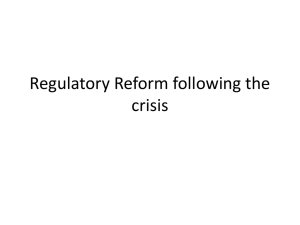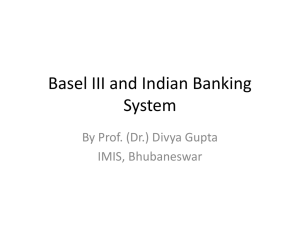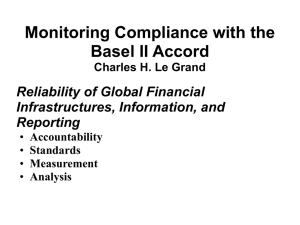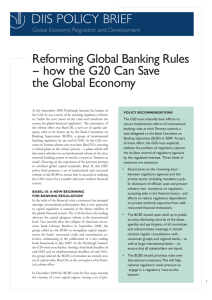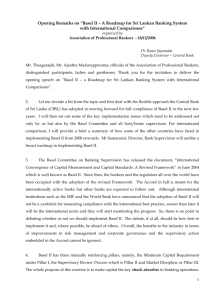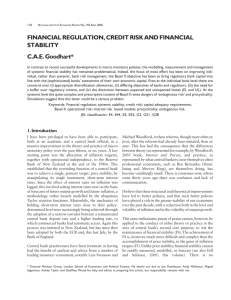Perspectives on the global regulatory agenda
advertisement
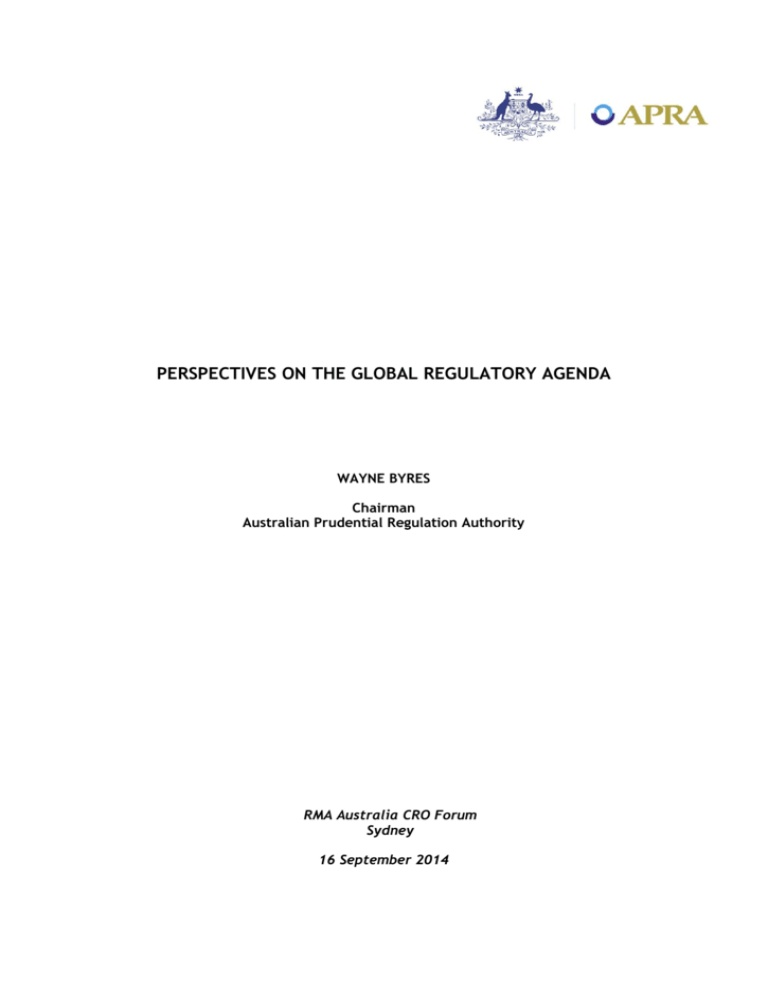
PERSPECTIVES ON THE GLOBAL REGULATORY AGENDA WAYNE BYRES Chairman Australian Prudential Regulation Authority RMA Australia CRO Forum Sydney 16 September 2014 PERSPECTIVES ON THE GLOBAL REGULATORY AGENDA Thank you for the invitation to be here this morning. I’ve been asked to offer some perspectives on the future global and local regulatory agenda for banking. At this point in time, it is somewhat difficult to offer too much of a view on the local regulatory agenda – the Financial System Inquiry (FSI) is examining that issue in great detail, and it would be somewhat presumptuous of me to set out a regulatory roadmap ahead of the Panel’s recommendations, let alone the Government’s response. As a result, I will largely confine my remarks this morning to the global agenda. Of course, as the FSI has already noted, in banking it is not possible to disentangle global from local developments entirely. Global minimum standards are a very important influence on the local regulatory framework – they form the base from which we build – so my remarks this morning will not be entirely devoid of local relevance. Phases of the post-crisis response The response of the public sector to the financial crisis can be categorised into four broad phases. These phases overlap somewhat, and not every jurisdiction has followed them in quite the same order, but nonetheless to my mind they provide a useful guide for categorising all that has been done, and is still to be done, in the programme of post-crisis reforms. The first phase of activity had nothing to do with the regulatory framework itself. The objective of this phase was to shore up confidence in the core of the financial system during, and in the immediate aftermath of, the worst financial crisis since the Great Depression. When the crisis hit in the latter part of 2007, and then more forcefully in 2008, the various arms of public policy swung into action to mitigate the risks to the real economy from a sharp deterioration in the health of the banking system. Fiscal stimulus, substantially looser monetary policy, liability guarantees (both wholesale and retail), emergency liquidity support and bans on short-selling, amongst other things, were all used in some shape or form to help stabilise the financial system. In some cases, nationalisation of failed banks (and non-banks) was necessary. In addition, the Supervisory Capital Assessment Program (SCAP) was instituted in the US to stress test the largest bank holding companies and, if needed, utilise funds from the Troubled Asset Relief Program (TARP) to recapitalise them. To deal with lingering doubts about the health of the European banking system, the Single Supervisory Mechanism (SSM) of the European Central Bank is now undertaking a similar stress testing exercise in the eurozone. The second phase of the post-crisis response was when, while working to stabilise their domestic financial systems, policymakers set to work internationally to agree new standards to substantially improve the resilience of financial institutions to future shocks, and thereby reduce the probability of bank failure. The centrepiece of this effort was the Basel III reforms agreed by the Basel Committee, and endorsed by the G20 Leaders, in 2010. Recognising its central role in the post-crisis response, G20 Leaders’ communiques between 2010 and 2013 regularly stressed the importance of the full, timely and consistent implementation of Basel III. It was supplemented by additional capital requirements for banks deemed systemically important, both in a global and a domestic context. There is still an active programme of work in the international standard-setting bodies to upgrade the regulatory framework in light of the lessons from the crisis (eg completing the Net Stable Funding Ratio and leverage ratio, as well as redesigning the capital requirements for the trading book and securitisation, and reviewing the standardised approaches to credit and operational risk), but the ‘big ticket’ proposals are now largely complete. There is a heavy emphasis now on national implementation. The third phase, which is the main item on the agenda in international forums at present, is attempting to minimise the impact of bank failure – improving resolution regimes and, in particular, tackling ‘too-big-to-fail’. In many cases, the financial crisis highlighted the shortcomings in the capacity of authorities to deal with the failure of one or more large banks – both formal powers, and practical preparations. Moreover, these shortcomings often exacerbated the crisis – the realisation of the absence of a clear plan for ensuring the orderly managing of a bank under stress further undermined investors’ confidence in the financial system. At the centre of international efforts to rectify this situation has been the Financial Stability Board’s Key Attributes of Effective Resolution Regimes for Financial Institutions, which, as the name implies, set out the critical components of an effective regime for dealing with failing banks. At this stage, much more remains to be done around the world to fully implement the Key Attributes. Improved resolution regimes offer potentially big benefits to financial stability at low cost. When coupled with greater investment in crisis planning, the potential impact of disruptive failures can be substantially reduced. The final phase is still to fully come to the fore, but is probably the most fundamental if we want to be able to say we have done the best we can to avoid a repeat of the excesses that built up during the crisis: that is, improve the behaviour of the industry itself. At the heart of the crisis were failings in the governance and management of individual financial institutions. True, market discipline and regulation failed to adequately detect and punish these failings, but that does not diminish the responsibility of those tasked with the stewardship of these institutions. In particular, personal incentives within banks became severely misaligned with the banks’ own long-term interests, let alone those of the community more generally. Initial efforts internationally focussed on the FSB’s Principles for Sound Compensation Practices, and the supplementary Implementation Standards. But this issue is broader than simply compensation, and more work is underway in this area. This includes the FSB’s Guidance on Supervisory Interaction with Financial Institutions on Risk Culture, and an imminent update to the Basel Committee’s Principles for Enhancing Corporate Governance. Each of these four phases is critical to fully restoring the stability of, and confidence in, the financial system. But in none of the phases can we say the job is done. Those of us who attend international policy discussions know the meeting agendas are still very long – too long for me to go into detail on many of the issues still being debated. In the remainder of the time I have available, therefore, I want to focus on three key pieces of work that are underway at present that I think are highly relevant to Australia. 2 The role of internal models in regulatory capital calculations The first of these relates to the risk-based capital regime, which is at the core of efforts to reduce the probability of bank failure. Banks now face substantially higher minimum capital requirements, and must hold higher quality capital to meet these requirements. These steps should greatly strengthen confidence in the ability of the banking system to cope with future shocks. But these efforts are being undermined somewhat by an increasing lack of faith in the use of internal models by the largest banks to calculate risk-weighted assets. At the height of the financial crisis, investors turned away from the risk-based ratios as a measure of financial health, and quickly reverted to a basic leverage ratio. This was an interesting litmus test as to whether investors felt they could rely on the internal-model based measures of capital adequacy in times of stress: they did not. This unfortunate conclusion has been reinforced by the recent studies by the Basel Committee, which found excessive levels of variability in bank calculations of risk weighted assets for identical portfolios. In light of these outcomes, the Chairman of the Basel Committee has made it clear that there is a problem, and something must be done about it.1 Capital ratios are the cornerstone of any analysis of bank financial health, for investors as much as regulators. While Basel III has done much to ensure the numerator of the capital ratio is a genuine measure of a bank’s capacity to absorb loss, doubts about the reliability of risk measurement in the denominator mean that the resulting ratios lack credibility as a reliable measure of financial strength. So as it stands, the future of internal models in the regulatory framework is somewhat in the balance. APRA’s preference is to find ways to strengthen current risk-based regime: there are many benefits from a risk-based capital system and we don’t want to see the baby thrown out with the bathwater. Simpler measures such as the leverage ratio should remain a backstop as originally intended (albeit a meaningful backstop). But the banking industry globally is going to have to accept that this is not just a bankregulator dialogue on technical issues of risk modelling. Unless investors have faith in the resulting risk-based capital ratios, they do not serve their full regulatory purpose. And if that is the case, simpler metrics will inevitably become more important – and potentially even binding. Additional loss absorbing capacity Basel III was, as I have noted, largely designed to reduce the probability of bank failure. In other words, it had a heavy emphasis on preserving a bank as a going concern. But even with the best designed regulatory and supervisory system, there can be no guarantees – the probability of failure will not be zero. So attention has turned in more recent years to reducing the impact of failure, particularly for those banks perceived to be too-big-to-fail. 1 ‘Restoring confidence in banks’, Keynote address by Stefan Ingves, Chairman of the Basel Committee on Banking Supervision and Governor of Sveriges Riksbank, to the 15th Annual Convention of the Global Association of Risk Professionals, New York, 4 March 2014. 3 The international standard-setters have adopted a so-called ‘book ends’ strategy to deal with too-big-to-fail. At one end, there is an additional capital requirement for those banks deemed systemically important from a global or domestic perspective, designed to reduce their probability of failure even further. But there has also been a great deal of attention on improving options for resolution that don’t involve a call on the taxpayer as the first (and sometimes only) option. Of most interest at present is the work of the Financial Stability Board and the Basel Committee on proposals for global systemically important banks (G-SIBs) to have an additional layer of ‘loss absorbing capacity’ (LAC). That is, in addition to their higher regulatory capital, G-SIBs should also have some additional liabilities that can be bailed in to absorb losses in the event of failure, thereby allowing the critical economic functions of the bank to continue whilst the authorities are undertaking some form of orderly resolution process. The design of this LAC requirement is still a work-in-progress, but a proposal is due to be presented to the G20 later this year, ahead of consultation with the industry and other interested stakeholders. LAC is conceptually appealing; unfortunately, it is also difficult to put into practice. As APRA noted in its response the Interim Report of the FSI, while the perception of too-big-to-fail may be mitigated somewhat by providing greater clarity regarding the circumstances in which private-sector stakeholders will bear losses should a large bank need to be restructured or recapitalised, achieving this objective while maintaining financial stability will not be easy. It also does not come without costs and risks. At a minimum, the holders of debt subject to bail-in may seek additional spreads to cover any perception of increased risk. In a systemic crisis, bail-in of the creditors of one bank may lead to a run on other banks as their creditors seek to avoid a similar bail-in. At first glance, these concerns may not seem to matter since no Australian bank is a G-SIB, so this proposal does not directly affect Australia. But that does not mean we shouldn’t take a close interest in it, since: at least some jurisdictions are likely to extend the application of LAC beyond G-SIBs, meaning it has the potential to become a de facto standard more broadly; depending on its design, the presence/absence of LAC may have a bearing on how credit rating agencies assign ratings to senior unsecured debt, as some banks will have a much higher level of subordinated claims below their senior debt holders than others; and/or it may potentially change banks’ cost of funds, as investors make choices about the relative risk of lending to banks with LAC and those without. Too-big-to-fail has been a long-standing problem, and solving it would undoubtedly be a positive outcome. Measures that reduce implicit subsidies and price risk correctly should substantially improve the efficiency and competitiveness of the financial system. So we should not allow the difficult nature of the issue to deter us from further work. But we equally need to recognise that long-standing problems rarely have an easy answer. 4 Governance and culture As the output from the regulatory pipeline begins to slow, and more focus is given to supervisory matters, greater attention is going to be given to issues of governance and culture within financial institutions. The financial crisis highlighted too many examples of poor governance, and we continue to see the cultural failings in the world’s largest financial institutions play out in record fines and penalties for past behaviour. Building up capital and liquidity, and ensuring loss absorbing capacity in the event of failure, will undoubtedly make for a more resilient financial system. But they will only offer a partial remedy to the problems that were experienced unless there are behavioural changes as well. The culture of an organisation is a nebulous concept, difficult to define and observe. But improving culture is nevertheless critical to long-run stability. The Hon Justice Owen, in his findings from the HIH Royal Commission, lamented that too few protagonists in that particular episode stood back and asked themselves ‘is this right?’ Instead, the question was often ‘can I get away with this?’ 2 Unfortunately, we are seeing that this latter way of thinking was present in many parts of the global banking system. The misbehaviour that is now coming to light is sufficiently widespread that the industry cannot rely on the excuse of ‘a few bad apples.’ Something more has been amiss, and strong governance and oversight within financial institutions is needed to set this right. An increasing proportion of supervisory attention is therefore being directed to making assessments of organisational culture. The international community of supervisors is still grappling with how best to do this, and how to respond when a culture is shown to be in need of improvement. Much has to do with the incentives that individuals face and how they signal what an organisation values, and what it does not. It is clear that, for many financial institutions, aspirational statements of organisational culture were no match for the personal incentives that individuals faced when they had to make the choice that Justice Owen referred to. Getting incentives correctly aligned with long-term organisational interests is an important, even if under-appreciated and under-developed, part of the global post-crisis response. Conclusion My remarks today have been designed to provide some global perspectives, consistent with my original intention to steer away from domestic matters given the FSI’s on-going deliberations. But as I also noted in my opening comments, disentangling global and domestic issues in banking is never easy. Much of the post-crisis regulatory debate has been on the merits of Basel III – is it too onerous, or does it fail to go far enough? But increasingly Basel III is in place, and the world has adjusted to it – indeed, the most recent study by the Basel Committee shows the vast majority of global banks already meet the requirements that do not come into force until 2019 (or 2016 in Australia). It is, to some extent, yesterday’s news. Three other issues on the international agenda are, I think, far more interesting matters to discuss. The role and reliability of internal models within the capital adequacy framework, the need for additional loss absorbing capacity to further 2 ‘The Failure of HIH Insurance’, Report of the HIH Royal Commission, volume I, p lxiii 5 reduce the impact of failure, and the efforts to improve the governance and culture of financial institutions are much more important issues to be focussing on. Each has the potential, depending on how international developments play out, to have just as much, if not more, impact on the global, and Australian, banking sector than did Basel III. 6


